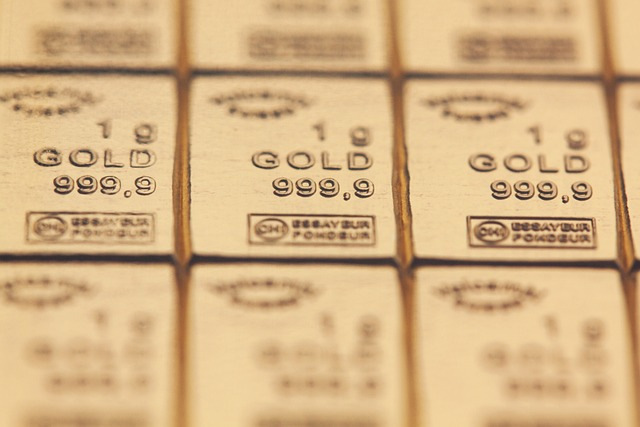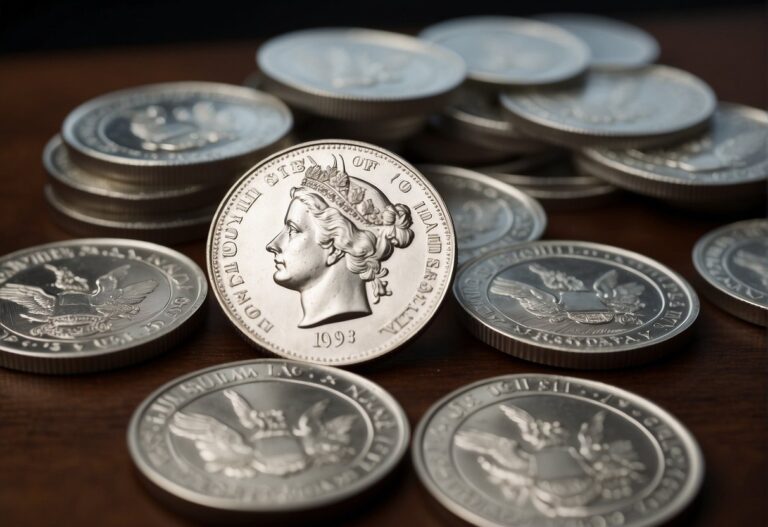How Much a gold bar is worth depends on several factors, including its weight, purity, and the prevailing spot price. The spot price of gold is the current market price at which gold can be bought or sold for immediate payment and delivery. It fluctuates regularly due to market forces, making the value of gold bars vary.
As an investment, gold bars hold an allure due to their tangible and lasting value, positioning them as a steady option during economic uncertainties.
Understanding the purity and weight of the gold bar is critical in determining its worth. Gold bars can come in different sizes and purities, from small one-gram bars to large 400-ounce bars held by central banks.
The purity of gold is denominated in karats or fineness, with 24 karats being pure gold. Many investors and collectors prefer purchasing gold bars from reputable manufacturers and brands, ensuring authenticity and quality.
How Much is a Gold Bar Worth? Key Takeaways
- Gold bar values are influenced by their weight, purity, and the gold spot price.
- Investment-grade gold bars are typically high purity and come in various sizes.
- Reputable brands and purity verification are critical for ensuring gold bar authenticity.
Historical Context of Gold Value
Gold has been a precious metal for millennia, recognized for its beauty and ability to store value. Historically, gold was first used for money around 550 BCE, demonstrating its longstanding financial significance.
During economic downturns, gold often retains its value better than other assets. Its relative stability in times of financial uncertainty contributes to its reputation as a “safe haven” for investors. Over time, the price of gold has fluctuated significantly, affected by various global events.
In the United States, before 1792, the value of gold was employed in creating the American dollar. The Gold Bullion price was about $19.39 per regular ounce in Alexander Hamilton’s era, and it remained relatively stable until the 1930s.
Throughout the 20th and 21st centuries, gold prices have continued to respond to world events such as wars, market crashes, and geopolitical shifts. Despite these changes, gold has maintained its allure as a store of value and investment.
Considering its historical performance, gold has not just been another commodity; it has played a pivotal role in human history’s financial narrative. As we trace its value back through decades, the importance of gold becomes evident in its consistent presence in the global economy.
Understanding Gold Purity and Weight
When exploring the value of gold bars, two critical factors must be considered: the weight of the gold, which is often measured in troy ounces, grams, or other units like tola and baht, and the purity or fineness, which denotes the proportion of actual gold in the bar.
Measuring Gold by Weight
The standard unit for weighing gold bars is the troy ounce, approximately 31.103 grams. Other standard units of measurement include:
- Grams (gr): A metric unit of weight, where 1 gram is one-thousandth of a kilogram.
- Tola: A traditional Indian unit of weight, with one tola approximately equal to 11.6638 grams.
- Baht: A unit used in Thailand, with 1 baht equaling 15.244 grams.
Gold bars can come in various weights, from small 1-gram bars to 400-troy-ounce London Good Delivery bars.
Gold Purity and Fineness
Purity refers to the amount of genuine gold in a bar and is expressed in terms of fineness. Fineness is a measure of gold content in parts per thousand. For example:
- A fineness level of 0.995 means the bar contains 995 parts of gold and five parts of other metals.
- The market also provides gold bars with purities of 0.999 to 0.9999, indicating a very high level of gold content.
Purity levels inform buyers about the quality of the gold they purchase. A higher purity level generally corresponds with a higher value of the gold bar.
Factors Affecting Gold Bar Prices and Value
The value of a gold bar is not constant and is influenced by several critical economic factors. Understanding these can help potential investors anticipate changes in the price of gold bars.
Gold Market Fluctuations
The spot price of gold is a critical factor in determining the price of gold bars. This spot price reflects the current market price for immediate delivery of gold and fluctuates constantly due to global economic conditions, geopolitical tensions, and market speculation.
Gold Demand and Supply
Gold prices are significantly affected by the balance between demand and supply. High demand from industries such as jewelry and electronics and limited supply can increase gold prices.
Conversely, prices tend to decrease when gold is abundant or demand falls.
Gold Investment Trends
Investors often turn to gold as a haven during economic uncertainty. Shifts in investment trends can influence the demand for gold bars, thereby affecting their value. For example, a trend towards higher interest in precious metals as an investment can increase demand and push the spot gold prices upwards.
Types of Gold Bars
Investors typically encounter two main types of gold bars: cast and minted, varying in manufacturing processes, sizes, and shapes. These variations significantly affect their market value and appeal to different kinds of investors.
Cast versus Minted Bars
Cast Bars are produced by pouring molten gold into molds, resulting in a product with a unique, rustic appearance. They usually have a lower premium over the spot price of gold, as the production process is less intricate.
On the other hand, Minted Bars are cut from a flat piece of gold and undergo meticulous treatment to achieve a high-quality finish with precise dimensions. They often feature intricate designs and are generally more expensive than cast bars due to the sophistication of their manufacturing process.
Sizes and Shapes
The physical attributes of gold bars can significantly vary. Small bars may range from 1 gram to 100 grams, which are remarkably manageable for retail investors. 1 oz gold bars are trendy due to their convenient size and balance between value and portability. Large bars, like the 400 oz London Good Delivery, are traded by central banks and bullion dealers, representing high-value transactions.
Shapes can be simple and rectangular, often the case with cast bars, or more elaborate with rounded edges and detailed designs found in minted bars. Each size and shape caters to specific market segments and investment strategies.
Gold Bar Branding and Manufacturers
When considering the value of gold bars, one must recognize the significance of branding and the reputation of the manufacturers. These elements directly impact investor trust and the global recognition of the gold bars on the market.
Reputation and Brand
The reputation of a gold bar brand plays a critical role in determining its value and market acceptance. A brand’s historical performance, the consistency of quality, and the adherence to international standards for purity are fundamental to building trust with consumers.
Brands like PAMP Suisse are esteemed for their meticulous attention to detail and security features, enhancing their value and prestige among investors.
Popular Gold Mints
Several mints worldwide are renowned for producing high-quality gold bars that are popular internationally. The Royal Canadian Mint and Perth Mint are prominent examples, both known for their exceptional products and longstanding history in the precious metals industry. These mints have garnered a loyal following due to their:
- Commitment to purity
- Advanced security measures
- Artistic designs
Moreover, both mints offer a range of sizes and weights, catering to diverse investment needs and preferences. Their hallmark on a gold bar assures investors of authenticity and quality.
The Role of Gold as an Investment
In the landscape of investment options, gold stands out for its historical stability and potential to diversify investment portfolios. It is often seen as a hedge against inflation and a protective asset during economic uncertainty.
Diversifying Portfolios With Gold
Investors frequently seek to manage risk by spreading their investments across various asset classes. Gold has a low to negative correlation with other financial assets, which means it often behaves differently from stocks and bonds.
By integrating gold into an investment portfolio, investors can reduce overall volatility and smooth out performance over time. For instance, when the stock market is down, gold prices might remain stable or even increase.
Gold and Inflation Hedging
Inflation erodes the currency’s value, resulting in a decrease in purchasing power. Gold is regarded as an effective inflation hedge due to its intrinsic value and scarcity. Historical data shows that the value of gold often rises in response to high inflation rates, which safeguards the purchasing power of investors’ capital. They rely on gold to maintain its worth over time, as opposed to holding cash, which might lose value in real terms when inflation is high.
Buying and Selling Gold Bars
Understanding the nuances of buying and selling gold bars is crucial when entering the precious metals market. Buyers must identify reputable bullion dealers, while sellers must know current gold values to ensure fair transactions.
How to Buy Gold Bars
Individuals looking to buy gold bars should start by researching and selecting a trusted bullion dealer. They offer different sizes of gold bars, and it’s vital to purchase bars with a purity of at least .995 for investment quality, as stated by SD Bullion. Costs of gold bars can fluctuate throughout the day due to the gold’s spot price; hence, buyers must stay informed about current market prices, as noted by the US Gold Bureau.
Steps to Buy Gold Bars:
- Determine Budget: Decide the amount one is willing to invest.
- Choose Size: Gold bars come in various weights, from 1 gram to 1 kilogram.
- Check Purity: Verify the gold bar is .995 fine gold or higher.
- Verify Authenticity: Ensure the gold bar has proper certifications and hallmarks.
- Complete Purchase: Facilitate the transaction through a secure payment method.
How To Sell Gold Coins and Bars
For a fair price, selling gold bars requires knowledge of the current gold market. Sellers should engage with established retail outlets or professional bullion buyers to find the best offers for their gold. It is often advantageous to compare offers from multiple buyers, especially when dealing with large quantities of scrap gold.
Key Considerations When Selling Gold Bars:
- Know the Spot Price: Understand the current value to avoid underpaying.
- Assess the Buyer: Engage only with reputable buyers to ensure the transaction’s integrity.
- Document the Transaction: Maintain records for legal and personal tracking.
By addressing these specifics, sellers can confidently engage in the gold market, ensuring a transparent and satisfactory transaction.
Gold Spot Price Versus Retail Pricing
Understanding the difference between the spot price of gold and the retail pricing is crucial for any investor or individual interested in purchasing gold bars. The spot price reflects the current market price for immediate delivery, while the retail price includes additional costs such as premiums.
Gold Spot Price Dynamics
The spot price of gold is a fluctuating value set by market forces, representing the price for one troy ounce of .999 fine gold. Multiple factors determine it, including supply and demand, market conditions, and geopolitical stability.
The spot price is continuously updated and serves as the benchmark for pricing across various forms of gold, including bars and coins.
Dealers establish an asking price slightly above the spot price, their selling price for gold products.
Calculating Gold Premiums and Total Cost
One pays the spot price plus a premium when purchasing a gold bar. The premium covers manufacturing costs, seller markup, and sometimes the relative scarcity of the bar. To calculate the total cost of a gold bar, one must add the premiums to the gold spot price. For example, if the spot price of gold is $1,800 per ounce and the premium is $50 per ounce, the total cost for one ounce would be $1,850. Premiums vary based on the bar’s size, brand, and where it is purchased.
Legal and Tax Considerations
When investing in gold bars, one must navigate both sales tax implications and obligations for reporting gold investments. Understanding these aspects is crucial as they directly affect the financial outcome of gold transactions.
Sales Tax on Gold
In the United States, sales tax on gold purchases varies by state, with some states offering exemptions for bullion or coins. For instance, investments in gold may be exempt from sales tax if they meet specific criteria, such as being considered legal tender or exceeding a certain fineness.
Private investors must verify sales tax regulations in their jurisdiction to understand the precise tax liability when purchasing gold bars.
Reporting Gold Investments
Regarding tax reporting, the Internal Revenue Service (IRS) requires taxpayers to report profits from the sale of gold bars as capital gains. These are taxed at a maximum rate of 28%, considered a collectible rate. Typically, gold investments held for more than a year fall under the long-term capital gains tax, while those held for a shorter period are subject to ordinary income tax rates.
Investors must report the sale of gold bars on Form 1099-B if they meet certain thresholds, mainly when transactions involve large quantities of precious metals. Keeping comprehensive records is essential for private investors, as they need to track their cost basis, sales, and any gains or losses.
Failure to properly report these investments can result in penalties, making diligent compliance a top priority.
Storage and Security of Gold Bars
Investing in gold bars necessitates careful consideration of storage and security to safeguard one’s assets. Effective solutions vary widely in complexity and cost, each offering different levels of protection and convenience.
Gold Home Storage Solutions
Security is paramount for investors choosing to store their gold bars at home. Home storage can range from a simple locked drawer to a more sophisticated safe. The safe must be both fireproof and burglar-resistant. Some may opt for hidden safes to enhance security, which can be concealed in walls or floors. The homeowner may face additional insurance costs to cover the stored gold and must balance accessibility against the theft risk.
Bank and Third-Party Storage
Alternatively, investors might consider bank safety deposit boxes for their gold bars, offering heightened security and peace of mind. Banks provide a secure environment with advanced protection measures. However, storage fees apply, varying based on the deposit box size. Third-party storage facilities are another option, often providing a dedicated vaulting service with around-the-clock security and insurance for a fee. These facilities may also allow for easier trading or liquidation of assets when desired.
Verifying Authenticity and Quality
Establishing their authenticity and quality is crucial to ensure the investment’s value when investing in gold bars. This process generally involves checking for proper documentation and identifiable marks on the gold bar.
Gold Assaying and Certificates
Assaying is a process that determines the metal content and purity of the gold bar. Reputable dealers and mints will provide an assay card certifying the bar’s weight, purity, and metal content. These cards are vital because they attest to the quality of the gold and confirm that it adheres to the stated specifications. Typically, gold bars are 99.99% pure, reflecting high-quality standards in the industry.
Serial Numbers Identification
Each gold bar should have a unique serial number imprinted on its surface. This number matches the one detailed on the assay card, serving as a critical security feature that confirms the bar’s authenticity. Buyers should verify the serial number on the bar and the accompanying documentation to ensure they match. This step is integral because it associates the physical bar with its documented authenticity, deterring counterfeiters and providing investors with peace of mind.
Gold Value Frequently Asked Questions
The value of gold bars can vary widely based on their weight and the current market price of gold. Here are some specific answers to common inquiries about gold bar worth.
What is the current price of a 400 oz gold bar?
The price of a 400 oz gold bar depends on the current market price, which fluctuates daily. The latest market data shows that costs can be found by checking real-time gold pricing resources or contacting a precious metals dealer.
How Much Is 1 oz Of Gold Worth?
The worth of gold per ounce is also subject to market fluctuations. One can refer to commodities market data or financial news websites for the most recent price.
What is the value of a 1-kilogram gold bar in today’s economy?
A 1-kilogram gold bar’s value is determined by the current gold price per gram multiplied by 1,000, as there are 1,000 grams per kilogram. The total value can be calculated using current market rates for gold.
How can I calculate the price of gold per gram?
To calculate the gold per gram, divide the current price per ounce of gold by 31.10, as there are approximately 31.10 grams in a troy ounce.
What Is A 10 Pound Gold Bar Worth??
To find the monetary worth of 10 pounds of gold, one would multiply the total number of ounces in 10 pounds (160 ounces, as there are 16 ounces in a pound) by the current price per ounce of gold.
How does the weight of a gold bar affect its market value?
The weight of a gold bar directly correlates to its market value; the heavier the bar, the greater the value. This is because the value is calculated by multiplying the bar’s weight by the current price per unit of weight (e.g., per gram or ounce).



